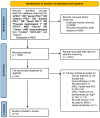Soluble PD-L1 as a Prognostic Factor for Immunotherapy Treatment in Solid Tumors: Systematic Review and Meta-Analysis
- PMID: 36430974
- PMCID: PMC9696773
- DOI: 10.3390/ijms232214496
Soluble PD-L1 as a Prognostic Factor for Immunotherapy Treatment in Solid Tumors: Systematic Review and Meta-Analysis
Abstract
Blocking the Programmed Cell Death Protein 1 (PD-1)/programmed death ligand-1 (PD-L1) axis has demonstrated great efficacy in cancer immunotherapy treatment and remains the central modality of immune targeting. To support the rational and tailored use of these drugs, it is important to identify reliable biomarkers related to survival. The role of the soluble form of the PD-L1 (sPD-L1) as a prognostic biomarker related to survival in solid cancer patients treated with immunotherapy has not yet been consistently evaluated. A systematic literature search of original articles in PubMed, MEDLINE and Scopus was conducted. Studies reporting hazard ratios (HRs) with a 95% confidence interval (CI) or Kaplan−Meier curves or individual patient data for overall survival (OS) or progression-free survival (PFS) associated with baseline levels of sPD-L1 in cancer patients undergoing immunotherapy treatment were considered eligible. Twelve studies involving 1076 patients and different tumor types treated with immunotherapy were included in the analysis. High blood levels of sPD-L1 correlated with poorer OS and PFS in cancer patients treated with immunotherapy (HR = 1.49, 95%CI: 1.15, 1.93, p < 0.01, I2 = 77% for OS; HR = 1.59, 95%CI: 1.20, 2.12, p < 0.01, I2 = 82% for PFS). A subgroup analysis highlighted that high levels of sPD-L1 were associated with worse survival in patients affected by NSCLC (HR = 1.81 95%CI: 1.09−3.00, p = 0.02, I2 = 83% for OS; HR = 2.18, 95%CI: 1.27−3.76, p < 0.01, I2 = 88% for PFS). An HR > 1 indicated that patients with low levels of sPD-L1 have the highest rates of OS/PFS. In this meta-analysis, we clarified the role of sPD-L1 in different solid cancers treated exclusively with Immune checkpoint inhibitors (ICIs). sPD-L1 could represent a non-invasive biomarker that is easily dosable in the blood of patients. The pooled data from the selected studies showed that a high circulating concentration of sPD-L1 in cancer patients correlates with worse survival, suggesting that it may be a helpful prognostic biomarker for the selection of cancer patients before immunotherapy, thus improving the efficacy of ICIs and avoiding unnecessary treatment.
Keywords: immunotherapy; meta-analysis; prognostic biomarker; programmed death ligand-1 (PD-L1); solid cancer; soluble forms of IC receptors; soluble programmed death ligand-1 (sPD-L1); survival.
Conflict of interest statement
The authors declare no conflict of interest. The funders had no role in the design of the study; in the collection, analyses, or interpretation of data; in the writing of the manuscript, or in the decision to publish the results.
Figures






References
Publication types
MeSH terms
Substances
LinkOut - more resources
Full Text Sources
Medical
Research Materials

